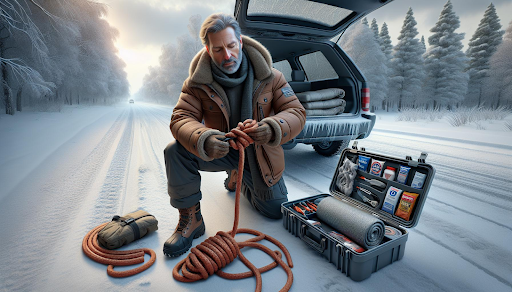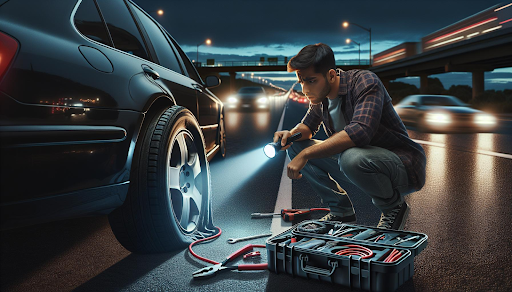
Image Source: DALL-E
Suppose an unforeseen health crisis emerges, particularly on a deserted road far from immediate medical aid. At this juncture, the ordinary items in a car kit, usually taken for granted, become incredibly significant.
For example, car ropes, which are basic items in your car emergency kit list, can prove themselves to be lifesavers. Now, learning the optimal usage of these car ropes in emergencies becomes paramount.
Consider car ropes in your emergency kit due to their multi-functionality – from fastening items securely to preparing impromptu stretchers, tourniquets, or even harnesses for climbing or descending difficult terrains in the most unanticipated road conditions. Other essential items are a flashlight or jumper cables to complement the car ropes in your roadside emergency kit.
Let’s delve into understanding how to use car ropes effectively during emergencies. This will prepare you for handling urgent situations.
The Importance of Being Prepared for Roadside Emergencies

Image Source: DALL-E
Timely response matters in emergencies and being prepared makes all the difference.
Remember, owning a variety of car ropes as part of your car kit enhances your preparedness for unforeseen circumstances on the roadside. For a comprehensive selection of high-quality ropes, consider checking out ProRope.com.
Common Roadside Emergencies
Ready yourself for common roadside emergencies. Having a roadside assistance service can greatly ease the stress of these emergencies. For example, Sam’s Roadside Service offers quick and reliable help, ensuring you’re back on the road as soon as possible, no matter the situation.
Flat tires, hitting the top list, happen out of nowhere. Even with advanced tire technology, punctures happen.
Dead batteries, commonly occurring in cold climates, leave your vehicle immobilized. Charging your batteries and keeping a spare one become important, especially in winter months.
Engine overheating frequently occurs during long trips or in severe heat. Regular engine checks prevent roadside mishaps.
Running out of fuel, an often overlooked emergency adds unnecessary stress. Keeping a keen eye on the fuel gauge and maintaining at least a quarter tank at all times avoids such predicaments.
Lastly, locked-in keys, while seemingly silly, cause delays and potential danger in secluded or high-risk areas. Spare keys come in handy in such cases.
For each of these emergencies, a well-prepared car emergency kit can help maintain security and endurance until help from roadside services arrives. Your car kit is your first defense in roadside emergencies. The essential items in your car emergency kit should include a flashlight, jumper cables, and a multi-tool among other useful items.
Preparing for these common situations can help you stay safe and potentially save lives during roadside emergencies with the support of a Roadside Service.
Essential Items for Your Car Emergency Kit
In light of your understanding of the multifunctionality of car ropes, a well-rounded car emergency kit, with essential and useful items, bolsters your readiness for unexpected situations.
Must-Have Items
When assembling a car emergency kit, focus primarily on a selection of basic items that serve multiple purposes. Your kit could include a first-aid kit, a multi-tool, jumper cables, a flashlight with extra batteries, and car ropes. Consider adding an emergency blanket for warmth in colder environments. These items equip you effectually during common roadside emergencies, such as a flat tire or a dead battery.
Additional Useful Items
Broaden your emergency preparedness by incorporating some additional resources into your car emergency kit. Items like hand warmers, a portable phone charger, an ice scraper, and bottled water expand the utility of your car kit. Checking these items for their expiry regularly and replacing them as needed ensures their usefulness when required.
These items in your car kit can provide invaluable security and endurance in emergencies, assisting you even in the most dangerous road conditions. So, having a well-prepared car emergency kit ensures safety until help arrives.
The Role of Car Ropes in Emergency Situations
By virtue of their versatile attributes, car ropes bear relevance in varying emergency scenarios. This section will expand on the types of car ropes and their functional utility in emergency situations.
Types of Car Ropes
Car ropes offer diversity in their make, each designed with a specific purpose to perform. Static ropes, for instance, have low elasticity, offering suitability for uses like anchor systems. Dynamic ropes, noted for their high elasticity, are beneficial in absorbing the impact of a fall, which constitutes their extensive usage in climbing operations.
Bungee ropes, displaying considerable stretchiness, are optimal for securing luggage on cars or can help in a pinch when a tow rope isn’t available. Similarly, tow ropes primarily aid in pulling vehicles stuck in obstacles such as mud, sand, or snow.
Reflective ropes, distinguished by their visibility in low light, are excellently practical for emergency applications at nighttime. To sum up, each of these car ropes, by virtue of their unique characteristics, provides prompt assistance in different emergency situations.
Preparing for Health Emergencies on the Road
An unprecedented health emergency on the road demands a well-equipped car emergency kit.
First Aid Essentials
When preparing your car kit, make sure to include first aid essentials. A stocked First Aid kit serves as the cornerstone of your car emergency kit. It encompasses basic items such as bandages, antiseptics, tweezers, scissors, and an emergency blanket.
Two notable items to include in your First Aid essentials are a multi-tool and hand warmers. The former transforms into a variety of necessary tools, while the latter helps maintain body temperature in cold road conditions. Keep a keen eye on the expiration date of all perishable items in your kit to ensure they won’t be dangerous if needed in an emergency.
Emergency Contacts and Information
Remember, staying safe in emergency situations extends beyond having a well-stocked car kit. Effective communication forms an integral part of road emergency preparedness. Keep a list of emergency contacts handy – this should include family numbers and emergency services for your area.
Moreover, consider keeping critical health information such as existing medical conditions, allergies, and medication details accessible in your car kit. This information facilitates medical help when on the side of a roadside emergency, particularly when you are unable to provide information yourself. Knowledge is indeed power when it comes to preparing for health emergencies on the road.
How to Use Car Ropes Safely and Effectively
This section provides insights on how to employ car ropes for health emergencies while ensuring safety.
Step-by-Step Guide
In an emergency, proper use of car ropes can make a significant difference. First, evaluate the situation to identify a suitable approach involving the car rope. Often, you can use car ropes to either secure injured passengers or assemble makeshift support items. For example, creating a stretcher requires at least 6 feet of car rope:
- Locate two strong and straight branches on the sides of the road.
- Cut both branches down to approximately 5 feet in length.
- Loop the car rope on each end of the branches.
- Intertwine a blanket through the rope to create a makeshift stretcher.
Naturally, car ropes also come in handy for other makeshift tools, you just need to adapt their use to the situation.
Safety Precautions
Prioritize safety when handling car ropes during emergencies. Always remember to check for defects, as a compromised rope might fail during critical times. Importantly, protect your body from potential injuries by wearing gloves to prevent rope burns. Avoid rushing, but handle the rope smoothly and carefully, particularly when dealing with wounded individuals. Lastly, keep the rope away from open flames or sharp objects to prevent damage.
By following these instructions, your preparedness for a roadside emergency increases, taking full advantage of the valuable aspects of car ropes.
Best Practices for Maintaining Your Car Emergency Kit
To ensure your safety during unexpected roadside mishaps, proper maintenance of your car emergency kit makes a remarkable difference.
Regular Inspections
Perform routine inspections of your car emergency kit. Regular checks ensure none of the items expire or wear out, leading to their inefficacy in an actual emergency. Monitor the condition of the car ropes, flashlight, jumper cables, and other essential items for any physical damage or degradation. Replace defective items immediately.
Updating Your Kit Seasonally
Modification of your car emergency kit list as per the season is highly advisable. For hot, summer months, consider adding sunscreen, an extra water bottle, or even a fan. During colder months, the inclusion of an emergency blanket, hand warmers, and an ice scraper becomes essential. Different road conditions necessitate distinct types of gear. Thus, seasonal updates can help you stay ready and safe against varying emergency situations.
Conclusion
So, you’ve seen how car ropes can be a real game changer in health emergencies. They’re not just versatile but can be lifesavers, helping you create essential tools like stretchers and tourniquets when you’re in a pinch. Having them in your emergency kit is crucial, especially when medical aid isn’t immediately available. Car ropes are more than just a tool, they’re an investment in your safety and preparedness. Don’t overlook their importance and make sure you’re ready for whatever the road throws at you.
